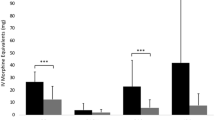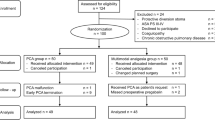Abstract
We aimed to determine whether early hospital discharge following minimally invasive surgery can be achieved through the use of preemptive multimodal analgesia without compromising patient safety or comfort. Data were retrospectively collected for 150 patients who underwent robotic-assisted laparoscopic hysterectomy for benign indications from 9 December 2009 to 6 October 2010 at Cox Health Systems (Springfield, MO, USA). One surgeon performed 100 consecutive cases with all patients receiving preemptive multimodal treatment with celecoxib and ropivacaine. These cases were compared with 50 patients treated with an opioid-based postoperative analgesia regimen by one of four other surgeons at the same center. Patient characteristics, perioperative outcomes, opioid requirement, and time to discharge were compared between groups. The patients in the multimodal group had significantly reduced opioid requirements intraoperatively (25.0 mg vs. 29.9 mg, P = 0.0077), postoperatively on the day of surgery (10.9 mg vs. 17.9 mg, P = 0.0030), and on the first postoperative day (3.1 mg vs. 15.3 mg, P = 0.0001). There were no differences in procedure time, transfusions, or readmission rates between groups. Time in the Post-Anesthesia Care Unit (PACU) was decreased in the multimodal group (72.0 min vs. 88.4 min, P < 0.0001), as was time to discharge from the hospital (8.5 h vs. 30.2 h, P < 0.0001). Age and body mass index were both significantly lower in the multimodal group; however, regression analyses demonstrated that analgesia regimen was the only parameter that predicted opioid requirement and time to discharge. Preemptive multimodal analgesia reduced the total dose of rescue opioids, facilitating same-day discharge without compromising patient comfort or safety.




Similar content being viewed by others
References
Lowe MP, Hoekstra AV, Jairam-Thodla A, Singh DK, Buttin BM, Lurain JR, Schink JC (2009) A comparison of robot-assisted and traditional radical hysterectomy for early-stage cervical cancer. J Robotic Surg 3:19–23. doi:10.1007/s11701-009-0131-0
Hoekstra AV, Jairam-Thodla A, Rademaker A, Singh DK, Buttin BM, Lurain JR, Schink JC, Lowe MP (2009) The impact of robotics on practice management of endometrial cancer: transitioning from traditional surgery. Int J Med Robot 5:392–397. doi:10.1002/rcs.268
Abdollahi SF, Bahlouli A, Mostafa PG, Rasooli S, Morteza G (2009) Comparison of laparoscopy-assisted hysterectomies with conventional hysterectomies. Saudi Med J 30:813–816
Tewari A, Srivasatava A, Menon M (2003) A prospective comparison of radical retropubic and robot-assisted prostatectomy: experience in one institution. BJU Int 92:205–210
Park JS, Choi GS, Lim KH, Jang YS, Jun SH (2010) S052: a comparison of robot-assisted, laparoscopic, and open surgery in the treatment of rectal cancer. Surg Endosc 25:240–248. doi:10.1007/s00464-010-1166-z
Shashoua AR, Gill D, Locher SR (2009) Robotic-assisted total laparoscopic hysterectomy versus conventional total laparoscopic hysterectomy. JSLS 13:364–369
Luo ZD, Chaplan SR, Higuera ES, Sorkin LS, Stauderman KA, Williams ME, Yaksh TL (2001) Upregulation of dorsal root ganglion (alpha)2(delta) calcium channel subunit and its correlation with allodynia in spinal nerve-injured rats. J Neurosci 21:1868–1875
Ong CK, Lirk P, Seymour RA, Jenkins BJ (2005) The efficacy of preemptive analgesia for acute postoperative pain management: a meta-analysis. Anesth Analg 100:757–773
Trabulsi EJ, Patel J, Viscusi ER, Gomella LG, Lallas CD (2010) Preemptive multimodal pain regimen reduces opioid analgesia for patients undergoing robotic-assisted laparoscopic radical prostatectomy. Urology 76:1122–1124. doi:10.1016/j.urology.2010.03.052
Fu PL, Xiao J, Zhu YL, Wu HS, Li XH, Wu YL, Qian QR (2010) Efficacy of a multimodal analgesia protocol in total knee arthroplasty: a randomized, controlled trial. J Int Med Res 38:1404–1412
Helvacioglu A, Weis R (1992) Operative laparoscopy and postoperative pain relief. Fertil Steril 57:548–552
Goldstein A, Grimault P, Henique A, Keller M, Fortin A, Darai E (2000) Preventing postoperative pain by local anesthetic instillation after laparoscopic gynecologic surgery: a placebo-controlled comparison of bupivacaine and ropivacaine. Anesth Analg 91:403–407
Pettersson N, Emanuelsson BM, Reventlid H, Hahn RG (1998) High-dose ropivacaine wound infiltration for pain relief after inguinal hernia repair: a clinical and pharmacokinetic evaluation. Reg Anesth Pain Med 23:189–196
Payne TN, Dauterive FR (2008) A comparison of total laparoscopic hysterectomy to robotically assisted hysterectomy: surgical outcomes in a community practice. J Minim Invasive Gynecol 15:286–291. doi:10.1016/j.jmig.2008.01.008
Reza M, Maeso S, Blasco JA, Andradas E (2010) Meta-analysis of observational studies on the safety and effectiveness of robotic gynaecological surgery. Br J Surg 97:1772–1783. doi:10.1002/bjs.7269
Boggess JF (2008) A comparative study of three surgical methods for hysterectomy with staging for endometrial cancer; robotic-assistance, laparoscopy, laparotomy. Am J Obstet Gynecol 199:360.e361–360.e369. doi:10.1016/j.ajog.2008.08.012
Jacoby VL, Autry A, Jacobson G, Domush R, Nakagawa S, Jacoby A (2009) Nationwide use of laparoscopic hysterectomy compared with abdominal and vaginal approaches. Obstet Gynecol 114:1041–1048. doi:10.1097/AOG.0b013e3181b9d222
Smith LH, Waetjen LE, Paik CK, Xing G (2008) Trends in the safety of inpatient hysterectomy for benign conditions in California, 1991–2004. Obstet Gynecol 112:553–561. doi:10.1097/AOG.0b013e318183fdf2
Estebe JP, Le Corre P, Le Naoures A, Eliat C, Chevanne F, Husson JL, Ecoffey C (2009) Local anaesthetic use for the iliac crest-donor site: pharmacokinetic and pharmacodynamic evaluations. Acta Anaesthesiol Belg 60:39–45
Katz JA, Bridenbaugh PO, Knarr DC, Helton SH, Denson DD (1990) Pharmacodynamics and pharmacokinetics of epidural ropivacaine in humans. Anesth Analg 70:16–21
Concepcion M, Arthur GR, Steele SM, Bader AM, Covino BG (1990) A new local anesthetic, ropivacaine. Its epidural effects in humans. Anesth Analg 70:80–85
Scott DB, Lee A, Fagan D, Bowler GM, Bloomfield P, Lundh R (1989) Acute toxicity of ropivacaine compared with that of bupivacaine. Anesth Analg 69:563–569
Knudsen K, Beckman Suurkula M, Blomberg S, Sjovall J, Edvardsson N (1997) Central nervous and cardiovascular effects of i.v. infusions of ropivacaine, bupivacaine and placebo in volunteers. Br J Anaesth 78:507–514
Bamigboye AA, Justus HG (2008) Ropivacaine abdominal wound infiltration and peritoneal spraying at cesarean delivery for preemptive analgesia. Int J Gynaecol Obstet 102:160–164. doi:10.1016/j.ijgo.2008.03.019
Brooks PM, Day RO (2000) COX-2 inhibitors. Med J Aust 173:433–436
Elia N, Lysakowski C, Tramer MR (2005) Does multimodal analgesia with acetaminophen, nonsteroidal antiinflammatory drugs, or selective cyclooxygenase-2 inhibitors and patient-controlled analgesia morphine offer advantages over morphine alone? Meta-analyses of randomized trials. Anesthesiology 103:1296–1304
Lombardi AV, Berend KR, Adams JB (2010) A rapid recovery program: early home and pain free. Orthopedics 33:656. doi:10.3928/01477447-20100722-38
Senard M, Deflandre EP, Ledoux D, Roediger L, Hubert BM, Radermecker M, Libbrecht D, Joris JL (2010) Effect of celecoxib combined with thoracic epidural analgesia on pain after thoracotomy. Br J Anaesth 105:196–200. doi:10.1093/bja/aeq129
Nezhat C, Lavie O, Lemyre M, Gemer O, Bhagan L (2009) Laparoscopic hysterectomy with and without a robot: Stanford experience. JSLS 13:125–128
Giep BN, Giep HN, Hubert HB (2010) Comparison of minimally invasive surgical approaches for hysterectomy at a community hospital: robotic-assisted laparoscopic hysterectomy, laparoscopic-assisted vaginal hysterectomy and laparoscopic supracervical hysterectomy. J Robot Surg 4:167–175. doi:10.1007/s11701-010-0206-y
Payne TN, Dauterive FR, Pitter MC, Giep HN, Giep BN, Grogg TW, Shanbour KA, Goff DW, Hubert HB (2010) Robotically assisted hysterectomy in patients with large uteri: outcomes in five community practices. Obstet Gynecol 115:535–542. doi:10.1097/AOG.0b013e3181cf45ad
Kho RM, Hilger WS, Hentz JG, Magtibay PM, Magrina JF (2007) Robotic hysterectomy: technique and initial outcomes. Am J Obstet Gynecol 197:113 e111–e114. doi:10.1016/j.ajog.2007.05.005
Reynolds RK, Advincula AP (2006) Robot-assisted laparoscopic hysterectomy: technique and initial experience. Am J Surg 191:555–560. doi:10.1016/j.amjsurg.2006.01.011
Morrison JE Jr, Jacobs VR (2004) Outpatient laparoscopic hysterectomy in a rural ambulatory surgery center. J Am Assoc Gynecol Laparosc 11:359–364
Hollenbeck BK, Dunn RL, Gilbert SM, Strope S, Miller DC (2008) Effects of laparoscopy on surgical discharge practice patterns. Urology 71:1029–1034. doi:10.1016/j.urology.2007.12.066
White PF, Kehlet H, Neal JM, Schricker T, Carr DB, Carli F (2007) The role of the anesthesiologist in fast-track surgery: from multimodal analgesia to perioperative medical care. Anesth Analg 104:1380–1396, table of contents. doi:10.1213/01.ane.0000263034.96885.e1
McClellan SN, Hamilton B, Rettenmaier MA, Lopez K, John CR, Hu JC, Goldstein BH (2007) Individual physician experience with laparoscopic supracervical hysterectomy in a single outpatient setting. Surg Innov 14:102–106. doi:10.1177/1553350607303785
Lieng M, Istre O, Langebrekke A, Jungersen M, Busund B (2005) Outpatient laparoscopic supracervical hysterectomy with assistance of the lap loop. J Minim Invasive Gynecol 12:290–294. doi:10.1016/j.jmig.2005.03.013
Summitt RL Jr, Stovall TG, Lipscomb GH, Ling FW (1992) Randomized comparison of laparoscopy-assisted vaginal hysterectomy with standard vaginal hysterectomy in an outpatient setting. Obstet Gynecol 80:895–901
Thiel JA, Kamencic H (2006) Assessment of costs associated with outpatient total laparoscopic hysterectom. J Obstet Gynaecol Can 28:794–798
Acknowledgments
The authors would like to thank John Orr for statistical assistance and April Hebert, Ph.D. a consultant for Intuitive Surgical, for literature review.
Conflict of interest
Dr. Shultz is a proctor for Intuitive Surgical and is a member of their speaker’s bureau.
Author information
Authors and Affiliations
Corresponding author
Rights and permissions
About this article
Cite this article
Shultz, T.M. Preemptive multimodal analgesia facilitates same-day discharge following robot-assisted hysterectomy. J Robotic Surg 6, 115–123 (2012). https://doi.org/10.1007/s11701-011-0276-5
Received:
Accepted:
Published:
Issue Date:
DOI: https://doi.org/10.1007/s11701-011-0276-5




